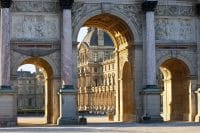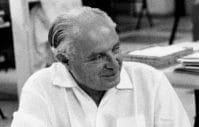
Rococo Style: How it Distincts in Architecture, Furnishings and Painting
Rococo Style: Birth and Development The Rococo, as a reflection of the trends, tastes and way of life of France…
Giovanni Ghisolfi (Milan, 1623 – 1683)
Capriccio with Resurrection of Tabitha
Oil on canvas, 50 x 74 cm
The work in question depicts a biblical episode against a background of classical architectural ruins. More precisely, Peter's second miracle is narrated. In Jaffa there lived a seamstress named Tabitha who was known for her kindness and her charitable works. At a certain point, Tabitha fell ill and died: the other disciples, hearing that Peter was in the nearby city of Lydda, sent for him. Arriving at Tabitha's house, Peter met other widows in tears, who showed him the clothes that the woman used to make for them. The apostle began to pray, alone, in the room where Tabitha had been left, and he said to her “Tabita, get up!”: When he had said these words, the woman resurrected.
The sequence of arches flanked by what remains of an Ionic temple, as well as the rocks and the bases of columns, between which the figures juggle, recall compositional solutions typical of Giovanni Ghisolfi. These elements are in fact found in classical scenes with ruins in Dresden, gemaldegalerie, or the Marina couple with ruins and Ruins on the coast of a private collection or even Dido finds the horse skull indicated to her by Juno at the point in which to found Carthage at the Sabauda Gallery in Turin. In the Apparition of Mercury to Alexander the Great in Hanover (Niedersachsisches Landesmuseum) we note instead the scaffolding for the reconstruction of the buildings, an expedient also used by Ghisolfi in two other canvases of similar subject but unknown location. Giovanni Ghisolfi was the forerunner of a pictorial genre that achieved extraordinary illustrative success only in the 18th century and with Giovanni Paolo Pannini. Ghisolfi was born in Milan in 1623, son of Giuseppe, an architect from Piacenza active in the Lombard capital in the XNUMXth century. the painter trained in a family environment and the first certain information on his activity comes when, in 1649, he is cited as having participated in the creation of the installations of triumphal arches and various pictorial decorations for the reception of Archduchess Marianna of Austria. Having moved to Rome around 1650 together with Antonio Busca, he probably took part in the Cortona construction sites and began an interesting collaboration with Salvator Rosa, for whom he painted landscapes and architectural views. From this partnership and from the observation of one of the pioneers of the genre, Codazzi, the Milanese learned the right way to insert the human presence within the architectural frame: his figures appear in fact executed with fluency, often distributed in the foreground, especially in the his first maturity. In the eternal city he certainly dedicated himself to the study of ancient architecture and the drawing of architectural fragments: this illustrative and archaeological propensity soon reveals an intimate classicist streak, marked by elegant compositional balances, which can also be found in the present. From 1659 we find him in Lombardy where he tries his hand at religious-themed decoration in the chapel dedicated to San Benedetto in the Certosa di Pavia and in the chapel of the Sacro Monte in Varese dedicated to the Presentation in the Temple. Having become a famous painter, we also find him decorating some palaces of the Milanese nobility, including Palazzo Omodei in Cusano Milanino and Palazzo Borromeo-Arese in Cesano Maderno and Palazzo Litta-Modignani in Varese. He also worked in Vicenza and Varese where, in 1675, he was called to decorate the vault and the presbytery and choir of San Vittore with The Glory of San Vittore. He died in Milan in 1683 and was buried in the church of S. Giovanni in Conca. Giovanni Ghisolfi, as well as a painter of large compositions with a sacred background, is today also known as a landscape painter and creator of caprices: with caprices we mean when, in painting, elements such as ruins, buildings and various architectural elements are combined together, often in an extravagant way . From these paintings by him emerges a sense of classicism, rendered through linear compositions, with light colors and diffused light, and a solid architectural setting that make Ghisolfi a forerunner of eighteenth-century landscape painting.
The object is in good condition
With Ars Antiqua it is possible to defer all amounts up to a maximum of €7.500 at ZERO INTEREST, for a total of 15 INSTALLMENTS.
E.g. Total €4.500 = Monthly installment €300 for 15 months.
E.g. Total €3.600 = Monthly installment €720 for 5 months.
For amounts exceeding €7.500 or for a longer period of time (over 15 installments), we can provide a personalized payment.
Contact us directly to get the best quote.
LIVE
– SUNDAY 17.00pm – 21.00pm Dig. terr. 126 + 809 SKY
– THURSDAY 21.00pm – 23.00pm Dig.terr. 134 + 809 SKY
– Streaming on our website www.arsantiquasrl.com and on our social networks Facebook and Youtube
All the works proposed by Ars Antiqua are sold accompanied by a certificate of authenticity in accordance with the law and an accurate information sheet.
It is possible to see the works directly at the showroom gallery in Milan, in via Pisacane 55 and 57.
We personally organize transport and deliveries of the works, both for Italy and abroad.

Rococo Style: Birth and Development The Rococo, as a reflection of the trends, tastes and way of life of France…

The Empire style, with its magnificent fusion of majesty and grace, remains an icon of classic furnishings, exerting a timeless charm…

Giò Ponti is one of the artists who most dominated the Italian post-war period, acting as a spokesperson for important innovations in the world…
have viewed this article in the last 30 minutes.